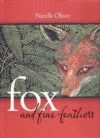The haunting eyes of a fox amongst striking ochre-and-green patterning on the front cover of Fox and Fine Feathers draw the reader into the book. This is a modern-day fable in which four Australian ground birds learn an important lesson about not getting obsessed with looks, the need to always stay vigilant, and the importance of looking out for your friends.
Narelle Oliver was creating stunning picture books about nature long before the recent publishing trend of narrative nonfiction nature-study books that includes the many titles in Walker’s Nature Storybooks series and a number of recent publications by CSIRO Publishing.
The well-researched text and images in Fox and Fine Feathers perfectly capture the sounds and behaviours of the four Australian native ground birds that feature in the narrative – Lyrebird, Coucal, Pitta and Nightjar. The story follows the four birds as they co-exist happily in the forest together. But then Lyrebird sees the reflection of his fancy tail in a pond and, like Narcissus, becomes obsessed with how he looks and the fascinating sounds he can produce.
Unfortunately, Coucal and Pitta join in with his self-flattery, and they all forget to keep an eye out for danger. Luckily for them, Nightjar – who looks like a pile of leaves scattered across the forest floor – is excluded from the group’s dangerously obsessive behaviour. And so, when hungry Fox wanders into the forest in search of food, it is Nightjar and his ability to camouflage himself that saves them all.
The book features coloured pencil, pastel and linocut illustrations. The decoratively complex texturing in the illustrations encourages close-looking and complex image-decoding. Oliver also uses framing to great effect. Different shaped and sized frames help to slow down or hasten the plot pacing, while images breaking frame, especially in the image of the leaping fox, create dramatic tension. This is an excellent book to include in visual literacy studies for older readers.
Folk-tale cadences infuse Oliver’s storytelling and help to effortlessly carry the reader along. Nonfiction information about the setting and the main characters is effortlessly imbedded in the well-researched lyrical text and detailed images, while notes at the back of the book provide extra information. A bibliography is also included. While it is a bit dated, it still provides a good starting-point for further research.
With its combination of stunning imagery, compelling text and well-researched information, it’s no wonder this book was an Honour Book in the 2010 CBCA Picture Book of the Year Awards and a shortlisted title in the 2010 Queensland Premier’s Literary Awards.

